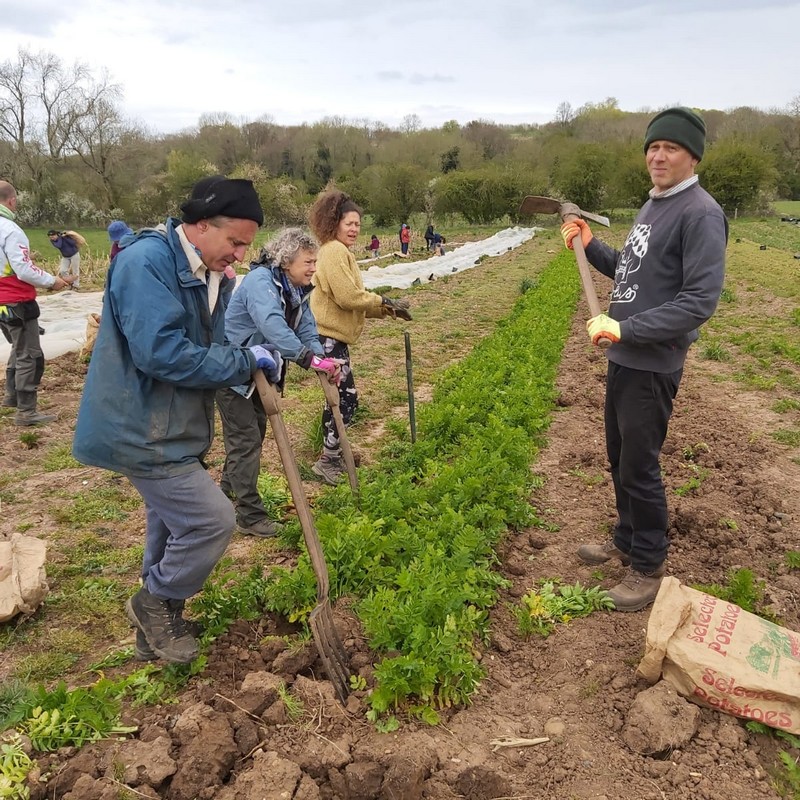Rob’s Recipe of the Week: Leek Pasta Bake
I’ve had this recipe on my list to try for a while but the stars have yet to align with me having everything I need in stock. One day!
Baked Pasta and Leeks with Anchovy Cream
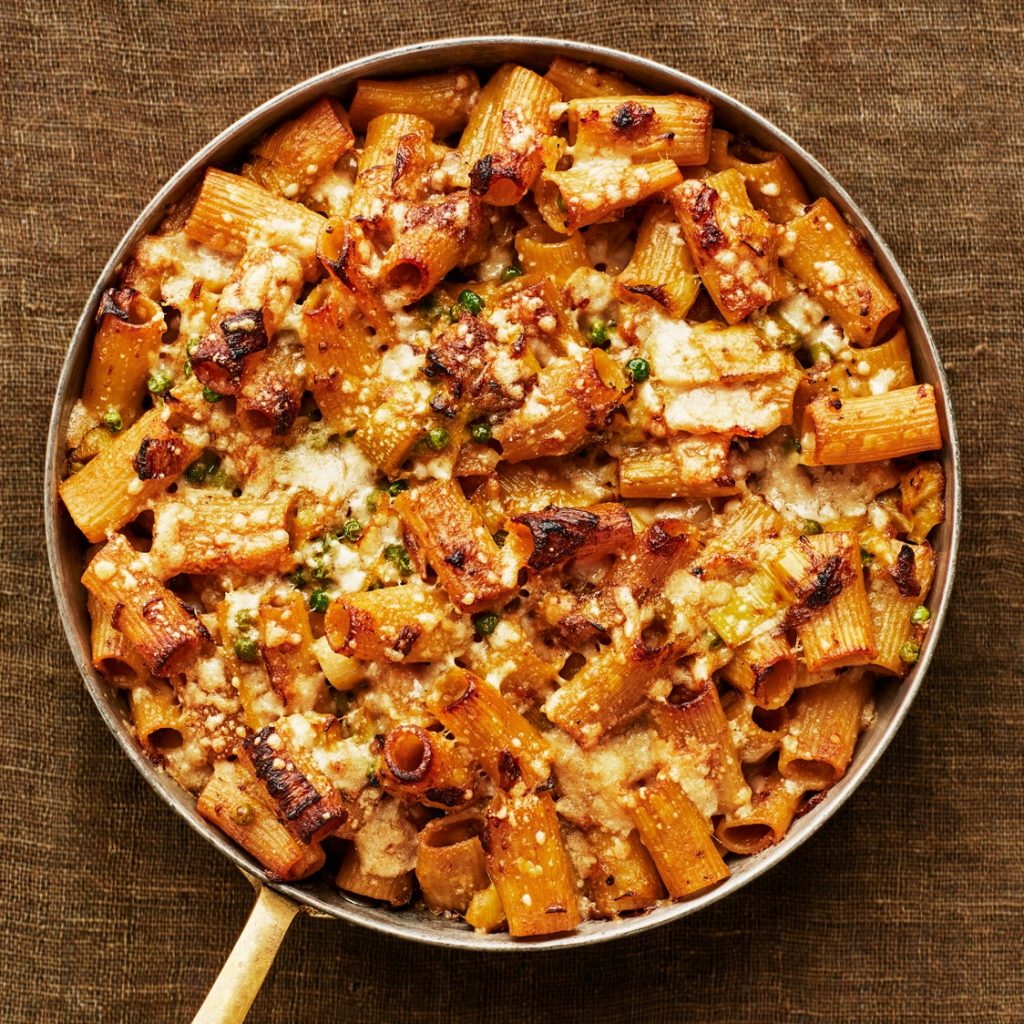
Ingredients (4-6 servings)
1lb. short pasta (such as rigatoni, penne, or conchiglie)
Kosher salt
¼ cup extra-virgin olive oil
3 large leeks (about 600g of), white and pale green parts only, trimmed, sliced ½” thick
15 oil-packed anchovies, drained (from a 1.5-oz. tin)
6 garlic cloves, thinly sliced
1 tsp. mild red pepper flakes or ½ tsp. crushed red pepper flakes
Freshly ground black pepper
2 cups double cream
3oz. Parmesan, finely grated, plus more for serving
10-oz. frozen baby peas, thawed in warm water, drained
Method
Preheat oven to 200°. Cook pasta in a large pot of boiling salted water, stirring occasionally, until very al dente, about 2 minutes less than package directions. Drain and set aside.
Meanwhile, heat oil in a large Dutch oven or large high-sided skillet over medium. Add leeks; season with a couple pinches of salt. Cover and cook, stirring occasionally, until tender and golden around the edges, 6–8 minutes. Uncover and add anchovies, garlic, red pepper flakes, and several grinds of black pepper. Cook, stirring occasionally, until anchovies are disintegrated and garlic is tender, about 5 minutes.
Add cream and 3 oz. Parmesan. Bring to a simmer; season with salt and black pepper (it should taste a bit salty because the pasta will absorb some seasoning as it bakes). Add peas and reserved pasta and toss gently to coat; top with more Parmesan. Transfer pasta to oven; bake until top is crisp and cream is bubbling around the edges, 25–30 minutes. Let cool slightly before serving.
From https://www.bonappetit.com/recipe/baked-pasta-and-leeks-with-anchovy-cream
2021: April news – Weather Report
April has been a tough month for growers across the UK. High pressure has meant weeks with no rain – only 5mm had fallen until the rain came on Tuesday night. To put this into context, the driest April on record was 7.1mm back in 1938 and the average April rainfall in England over the last 4 yeas has been 28mm (2020), 35.4mm, 78.4mm and a very dry 2017 at 17.6mm.
It’s very unusual to have to irrigate bare land just to cultivate (prepare the land by ploughing, power harrowing etc) – let alone for establishing the first cultivations of the season – but this is what we’ve been doing the past couple of weeks. In very dry weather irrigation hoses are left to run on timers overnight but because there have also been a record number of frosts this month this wasn’t possible. A lot of time has been spent on this, as well as time each day covering and uncovering crops for protection from both the night’s frost and the heat in the day – an unusual combination.
As a consequence we are behind on many of our field plantings which have already been growing slowly because of the cold nights, and wouldn’t have survived planting out in the dry ground in these conditions. This also has a knock on for new sowings as we simply have no space in the hotbeds for them whilst the field crops are still there. This may well result in the hunger gap bei
It’s all a juggling act and has been a challenging few weeks for the team. Speaking to other growers we realise there is very little we can do other than pray the rain continues (but not too much!), the frosty nights come to an end and everything catches up. As always it is humbling to know we are really at the mercy of mother nature, who will always have the last word.
Rebecca’s Recipe of the Week: Parsnips, Squash, Capers, Parsley
Everyone knows roasted vegetables are good. Adding a punchy caper and parsley vinaigrette makes them even better. You can use different vegetables (potatoes, say), and you can also vary the vinaigrette by adding harissa paste, or using basil or mint instead of parsley.
Served with rice or another grain to soak up the vinaigrette, this makes a good weekday dinner. You can add some salted yoghurt if you want additional creaminess (and protein).
Roasted Parsnips and Squash with Caper Vinaigrette
Serves 3-4
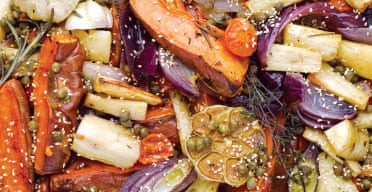
Ingredients
For the roast veg
700g parsnips, peeled
700g squash or pumpkin
120ml olive oil
4 medium red onions (optional)
4 sprigs of thyme
2 sprigs of rosemary
1 teaspoon salt
Several grinds of black pepper
1 whole head of garlic
10-20 small tomatoes, cut in half
For the dressing
1 large lemon
2 tablespoons olive oil
3 tablespoons capers, roughly chopped if they are large
1.5 teaspoons honey or maple syrup
½ teaspoon Dijon mustard
big handful of parsley, chopped fine
½ teaspoon salt
Several grinds of black pepper
Preparation
Prepare the roast veg:
Preheat oven to 190C.
Cut each parsnip into batons about 5cm long and 1.5 wide—but if they are small it is fine to leave them whole. They will look amusing in the finished dish.
Using your hand, scoop the seeds out the squash. (You can use these to make a nice nibble: https://www.101cookbooks.com/toasted-pumpkin-seeds/.) Peel the squash and cut it into chunks roughly the same size as your parsnips.
Peel the onions (if using) and cut each into 6 wedges.
Cut the head of garlic in half horizontally. Don’t break it into individual cloves or try to peel it! Just cut the whole thing into two pieces, horizontally.
Place the parsnips, squash, onions and garlic into a roasting tin and add 120ml olive oil, the thyme and rosemary, 1teaspoon salt, and some pepper. Mix well and spread it out in the pan so the vegetables are not all heaped on top of themselves. Place in the oven and roast for about 20 minutes, or until the vegetables look golden and are pretty tender.
After 20 minutes add the tomatoes, and roast for another 10 minutes or so, until the vegetables are completely tender when prodded with a fork and the tomatoes have softened.
While the vegetables are roasting prepare the vinaigrette: zest the lemon and then cut it in half so you can juice it. Combine the lemon juice (about 2 tablespoons) and zest with the other ingredients in a small bowl. Whisk to combine.
Finish the dish: Once the vegetables are done, remove them from the oven and pour the vinaigrette over the hot vegetables. Toss to combine and serve with rice or some other grain.
Recipe adapted from Yotam Ottolenghi, Plenty (2010).
Rob’s Recipe of the Week: Beets and Chard from the Share
As always I continue to try to find new ways to enjoy roasted beetroot as it takes us through the winter and this week I think I’ve found a good one. Either a fun lunch or a dinner padded out with some nice bread, you choose!
Warm lentils with roasted beets, wilted chard & goat cheese
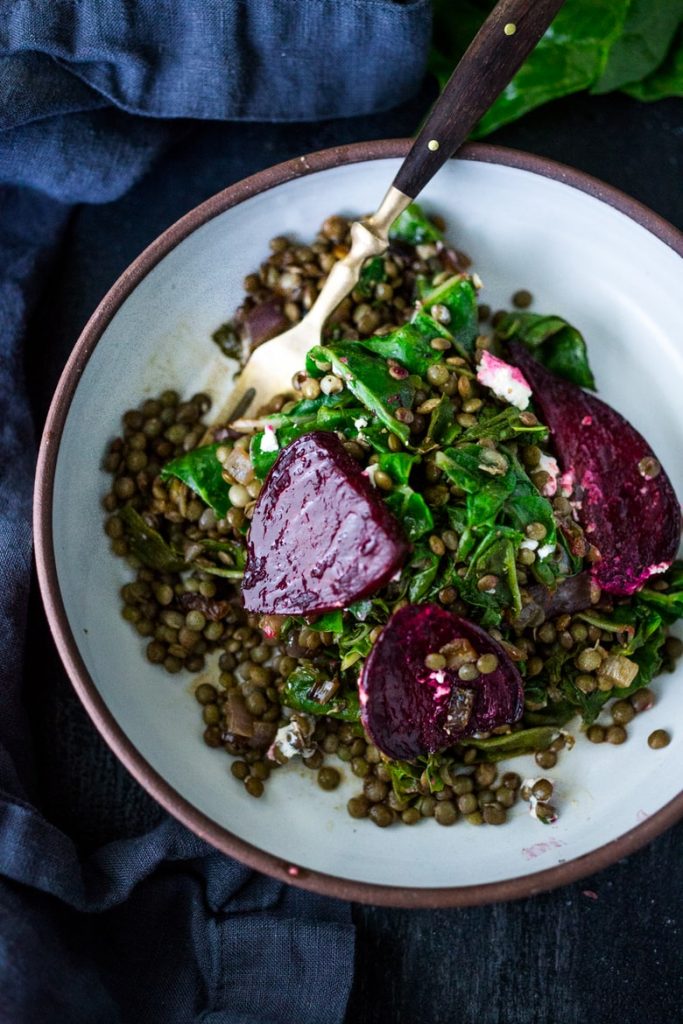
Ingredients
3–4 beetroot ( enough for 2 people)
2 cups cooked lentils
2 tablespoons olive oil
½ a red onion- diced
3 garlic cloves- rough chopped
4 cups (packed) swiss chard or rainbow chard- chopped (or sub beet greens, spinach)
salt and pepper to taste
1 tablespoon balsamic vinegar, more to taste
¼ cup goat cheese crumbles
2–3 tablespoons fresh basil, or parsley.
Instructions
Preheat oven to 220C. Scrub and trim beetrot and cut into ½ inch slices or wedges. Drizzle with olive oil and roast until tender, about 25- 30 minutes.
If cooking lentils, place ¾ cup dried lentils in a small pot and cover with 3 inches of water and a pinch salt. Bring to a boil, cover and turn heat down to a simmer, cook about 25-30 minutes or until tender but still hold their shape. Drain.
In a large frying pan, heat 2 tablespoons oil over medium high heat. Add diced onion and saute 3-4 minutes. Turn heat down to medium, add garlic and cook 2 more minutes, until golden and fragrant.
Lower heat to medium low. Add chard and gently wilt, just slightly, about 2-3 more minutes. Season with salt and pepper.
Add 2 cups cooked lentils to the frying pan, gently folding them in and warming. Season again with salt and pepper.
Add beetrot and splash with 1 tablespoon balsamic vinegar. Let vinegar cook down for just a couple of minutes so it’s not so acidic. Taste, add more vinegar if you like, cooking it down. Sprinkle with goat cheese and herbs. Taste again, if it tastes bland it most likely needs salt. Serve immediately.
From https://www.feastingathome.com/warm-lentils-wilted-chard-roasted-beets-and-goat-cheese/
Rebecca’s Recipe of the Week: Spicy Potato-Parsnip Soup with Preserved Lemon
Here is a good soup for a blustery spring day. The warming spices—cumin, coriander, paprika—give this a North African flavour, as does the preserved lemon. You can make this with any ratio of potatoes or parsnips that you prefer, including all potato or all parsnip. We enjoyed this with a glass of very robust Bulgarian merlot but other drinks are available, as they say.
Note that this involves only one pan, and so results in minimal washing-up.
Spicy Potato-Parsnip Soup with Preserved Lemon
Serves 2
Ingredients
For the Soup
2 tablespoons rapeseed or olive oil
1 onion, roughly chopped
2 garlic cloves, roughly chopped
½ dried Canalside chile, deseeded if you don’t want it too hot and chopped, or 1 medium-hot dried chile, treated similarly
1 teaspoon ground cumin
1 teaspoon ground coriander
½ teaspoon sweet smoked paprika (use a Spanish brand)
¼ cup preserved lemon, chopped fairly coarsely
500g peeled potatoes and parsnips, in any ratio (you can use all potatoes or all parsnips, too)
About 750ml stock (I think you could also use water, to be honest)
1 teaspoon salt
To decorate the Soup
4 tablespoons yoghurt
a little more smoked paprika
a little extra preserved lemon, coarsely chopped
Preparation
Heat the oil in a large saucepan over medium heat. Add the onion, garlic and chile, reduce the heat to low, and sauté gently for 10-15 minutes, or until the onion is soft but not brown. Stir in the cumin, coriander and paprika and cook for a minute or two more, until everything smells fragrant.
Meanwhile, cut the peeled vegetables into chunks of about 2cm.
When the spices in the pan are fragrant add the vegetables and the preserved lemon and pour in the stock (or water) and the salt. Bring to a simmer and cook for 30-40 minutes, or until the vegetables are very tender indeed.
Using a potato masher, mash the vegetables to give the soup a coarse texture. Hugh F-W suggests passing the whole thing through a sieve to create a smooth puree, but this seems both a lot of work and a dubious outcome as in my view a more rustic texture suits this soup far better. But it’s up to you. Add a bit of water if it still seems a bit thick to you, and check to see if it would benefit from a bit more salt.
To serve, dish your soup into bowls and garnish each with several spoonfuls of yoghurt, a sprinkling of paprika, and some golden cubes of preserved lemon.
Recipe adapted from Hugh Fearnley-Whittingstall, River Cottage Veg Every Day! (2011).
Rob’s Recipe of the Week: Time for spring!
Since spring greens and spring onions are in the share next week I’ve been trying to find light and fresh recipes to celebrate the light evenings and good weather. This one looks like it could take some effort with all the rolling and re-rolling but hopefully you’ll be rewarded with some nice crisp layers!
Scallion pancakes

Ingredients:
FOR PANCAKES:
250 g plain flour
240 ml boiling water
60 ml plus 2 tbsp. vegetable oil
2 tbsp. sesame oil
100 g thinly sliced spring onions, from about 4 whole spring onions
FOR DIPPING SAUCE:
2 tbsp. rice wine vinegar
2 tbsp. soy sauce
1 spring onion, thinly sliced
Pinch crushed chilli flakes (optional)
Method:
Combine flour and boiling water in a large bowl and stir to combine until a mass of dough forms. Transfer dough to a lightly floured surface and knead until smooth, slightly tacky ball forms, 3 to 4 minutes.
Transfer dough ball to a medium bowl and cover with a kitchen towel or cling film. Let rest 30 minutes at room temperature, or up to overnight in the fridge.
Meanwhile, mix 2 tablespoons vegetable oil and sesame oil in a small bowl.
Make dipping sauce: in a small bowl, stir together vinegar, soy sauce, spring onions, and chilli flakes.
Separate dough into four equally-sized balls. Return 3 to bowl and recover with kitchen towel or cling film. Roll remaining ball into an 8” disk, and brush with a thin layer of the oil mixture. Roll tightly, then twist into a tight spiral, tucking the outer end underneath the roll. Using the palm of your hand, flatten the spiral, then roll out again into an 8” disk. Brush the top with another thin layer of oil, and scatter with 1/4 sliced spring onions. Roll up disk again, then re-roll into spiral. Re-roll into an 8” disk, then repeat with remaining dough balls.
Add ¼ vegetable oil to an 8” pan over medium-high heat until shimmering and gently add first pancake. Cook, undisturbed, until golden on one side. Flip and cook until golden on underside, about 2 to 3 minutes per side. Remove to paper-towel lined plate and season immediately with salt. Repeat with the remaining pancakes, adding more oil if necessary.
Cut pancakes into triangles and serve with dipping sauce.
From delish.com
Ali’s Recipe of the Week: Sneaky Veg Cake (with swede!)
The swede crop this year is doing very well, and if you’re running out of ways to use up this ubiquitous winter root, try this unusual recipe idea. The friend who suggested the recipe to me gave it the thumbs up, as did her 2 children, and with the use of ‘flax eggs’ it’s possible to make it vegan / egg and dairy allergy friendly – a must in that family. You should have enough swede from any size of share to make this cake.

Ginger swede cake
PREP TIME: 15 mins
COOK TIME: 40 mins
TOTAL TIME: 55 mins
INGREDIENTS
2 large eggs or two flax eggs – see notes below
100 g dark brown sugar
120 ml maple syrup or agave syrup
150 ml sunflower oil
2 pieces stem ginger finely chopped
2 tablespoons syrup from the stem ginger jar
175 g plain flour
2 teaspoons baking powder
2 teaspoons ground ginger
200 g grated swede
To ice (optional)
100 g icing sugar
1-2 tablespoons cold water
INSTRUCTIONS
Pre-heat the oven to 180°C(fan)/200°C/gas mark 6. Grease and line with baking paper a 20cm/8inch square cake tin.
Beat together the 2 eggs (or flax eggs), 100g brown sugar, 120ml syrup, 150ml sunflower oil, the chopped stem ginger and 2 tablespoons of ginger syrup in a large mixing bowl.
In a separate bowl sift together 175g plain flour, 2 teaspoons baking powder and 2 teaspoons ground ginger. Fold the dry ingredients into the wet ingredients until combined and finally mix in 200g grated swede.
Bake in the oven for 35-40 minutes until golden brown and a skewer inserted in the centre comes out clean. Leave to cool completely in the tin before turning out.
To ice (optional)
Mix together 100g sifted icing sugar with a tablespoon of cold water. Add the remaining water gradually, mixing it in as you go so it doesn’t get too runny. If you put in too much water simply sift in a little more icing sugar.
Drizzle over the cake and leave to set.
NOTES
To make 2 flax eggs mix together 2 tablespoons of ground flax seeds (also known as linseeds) with 6 tablespoons of cold water. Leave for a few minutes until you have a thick paste and then use in place of eggs in this recipe. You can also use chia seeds.
From Sneaky Veg
Rebecca’s Recipe of the Week: Squash, Mushrooms, Blue Cheese
Hugh Fearnley-Whittingstall describes this as a ‘River Cottage classic’, and it is easy to see why. The unctuous quality of roast squash combines well with the umami flavours of the mushrooms and cheese. It tastes rich and luxurious without being heavy or cloying.
You can also use other cheese such as shavings of parmesan, or a hard goat’s cheese in place of the blue cheese.
Warm Salad of Mushrooms and Roasted Squash
Serves 3-4
Ingredients
Salad
approx. 1kg squash
12 sage leaves
4 garlic cloves, thickly sliced
100ml rapeseed oil
large knob of butter
300g mushrooms, thickly sliced
Large handful of rocket or mixed salad
150g blue cheese, crumbled
Salt and pepper
Dressing
3 tablespoons rapeseed or olive oil
1 tablespoon balsamic vinegar
¼ teaspoon salt
a few grinds of pepper
Preparation
Preheat oven to 190C.
Peel halve and deseed the squash. Cut into 2-3cm chunks and put in a roasting pan along with the sage leaves, almost all the rapeseed oil and a generous seasoning of salt and pepper. Roast for about 40 minutes, stirring once, until soft and coloured at the edges.
While the squash roasts, prepare the dressing by combing the ingredients in a small lidded jar and shaking vigorously.
When you are ready to eat, put the last drizzle of oil in a frying pan with the butter. Heat over medium heat and then add the mushrooms, along with another pinch of salt and a grind of pepper. Fry for 3-5 minutes, or until they are cooked and any liquid they have released has evaporated.
Mix together the mushrooms and squash (in the roasting tin, or frying pan, say) and toss with the dressing. Array the rocket on a serving platter and then top with the squash and mushrooms. Distribute the cheese on top and serve it forth.
Recipe adapted from Hugh Fearnley-Whittingstall, River Cottage Veg Everyday! (2011).
2021: March news – Cauli Surprise
We decided to split our ploughing this year into two bulk lots to make it easier for the growers; an early and a late plough. Thanks to the recent dry weather we reached a major milestone for the new season this week having ploughed over half of the land, ready to prepare it for planting.
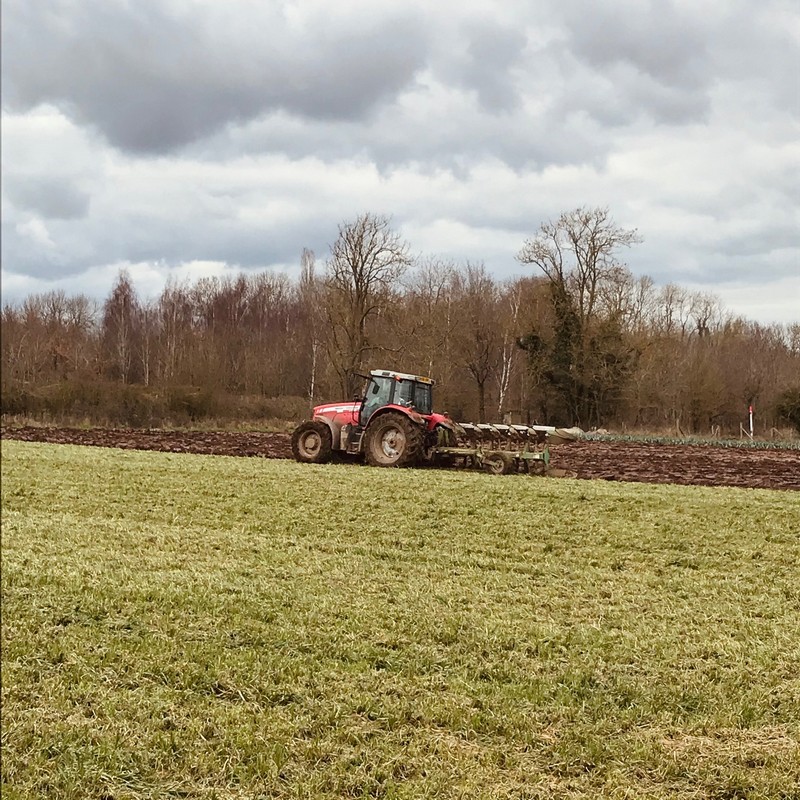
Ploughing underway 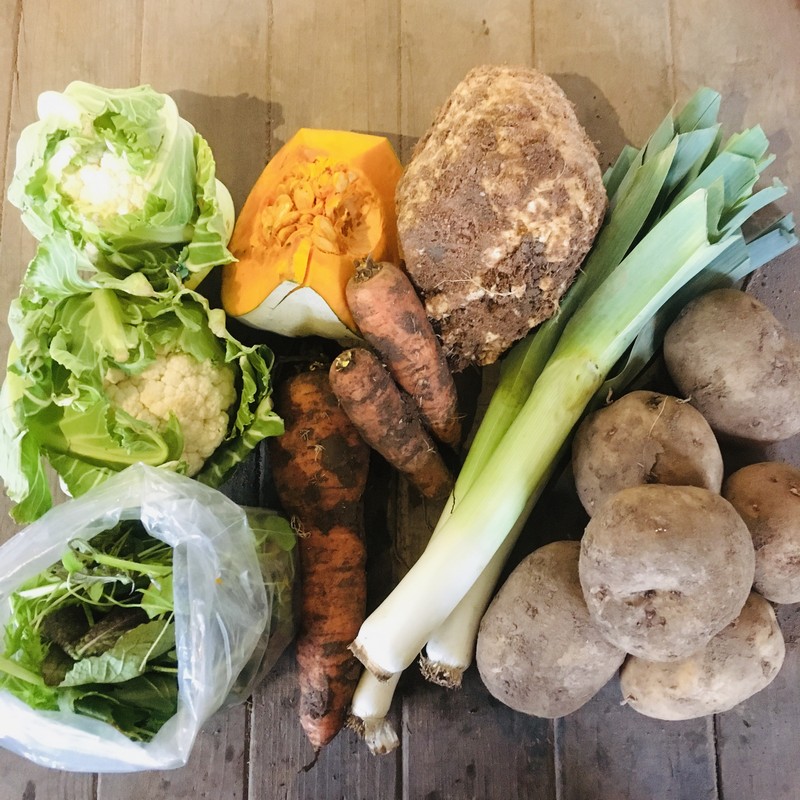
Surprise cauli in the share
We hope you enjoyed the first of the over wintering cauliflowers this week. Cauli’s are notoriously hard to harvest – there is a very small window to catch them between being under or over ripe so Stephen had a very happy surprise to find 180 plants perfectly ready on Monday.
Rebecca’s Recipe of the Week: Carrots, Lentils, Coconut, Spinach
Very good straight off the stove, and even better the next day. The grated carrot and spinach lighten the dhal, and also add beautiful little green and golden flecks to the duller gold of the lentils. The coconut milk stays in the background, adding sweetness and rich flavour without overwhelming the balance of tastes. This is good served with rice or bread, yoghurt and a pickle.
Quick Carrot Dhal
Serves 4
Ingredients
2 cloves garlic, peeled
thumb-sized piece of ginger, peeled
1 green chile, chopped—remove the seeds if you prefer
1 red onion, peeled
vegetable or coconut oil
1 teaspoon cumin seeds
1 teaspoon coriander seeds
1 teaspoon black mustard seeds
1 teaspoon ground turmeric
1 teaspoon ground cinnamon
½ teaspoon salt
200g red lentils
400ml coconut milk
600ml water
6 medium carrots, peeled and topped and tailed
2 large handfuls of spinach, coarsely chopped, or about 8 ‘cubes’ of frozen spinach
Juice of 1 lemon
Big handful of coriander, coarsely chopped
Preparation
Finely grate the garlic and ginger. Mince the onion.
Heat a large saucepan over medium heat and then add the oil. When it is hot add the garlic, ginger, chile and onion. Turn the heat to low and cook for 10 minutes until everything is soft but not browned. Stir periodically, so that it does not stick.
Meanwhile, toast the cumin and coriander seeds in a dry skillet for a few minutes, until they release a lovely smell. Set aside to cool for a few minutes, then put them into a mortar and crush them a little—they needn’t be ground.
Add the crushed cumin and coriander to the pan along with the other spices and salt. Turn up the heat to medium and cook for a minute or two. Now add the lentils, coconut milk and water and bring to a simmer. Turn the heat to low, cover and cook for 30 minutes, or until the lentils are tender. Add more water if it seems dry, and stir every one and then so it does not stick to the bottom of the pan.
While the lentils are cooking, grate the carrots coarsely and add to the lentils after they’ve cooked for about 20 minutes.
Once the lentils are tender, add the spinach and cook for a new more minutes until the fresh spinach wilts, or the frozen spinach defrosts and amalgamates into the dhal.
Stir in the lemon juice and the coriander. Taste, add more salt if you feel it necessary, and serve.
Recipe adapted from Anna Jones, The Modern Cook’s Year (2017).

